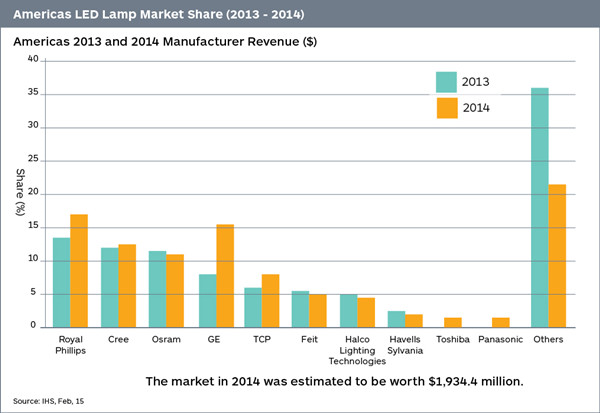2014 lighting market continues to transit to LED technology, the revenue of LED lamps increases from 25% in 2013 to 30% in 2014, and is expected to reach 67% in 2022, in terms of the global revenue for lights. Growing LED lighting technology market, suggest the shrinkage of halogen, compact fluorescent lamps and other traditional technology market, and larger lighting companies have been trying to adjust their businesses, while smaller and more specialized LED companies have entered the market, which further increasing the pressure on the existing vendors.

Market leader Philips managed to increase its LED lighting market share from 14% in 2013 to 17% in 2014, followed by Osram, Panasonic and Toshiba, with the market share of approximately 8 percent, 6% and 6% respectively ; GE increases from 3% in 2013 to 6% in 2014, but these “athletes” get lost in the traditional lighting market, which means that all of the top five overall lighting manufacturers have lost market share.
Light source market is more fragmented than the lighting market, Philips as a global market leader, accounted for only 6% of the market, while the top 10 manufacturers accounted for only 22% of the joint venture market. Overall, the light source market looks “brighter” than the lighting market, at least for the “top player”. The top five companies are: Philips, Acuity, Panasonic, Fort Ord and Cooper, both in 2014, cling to their market share.
The revenue share of LED light source increased from 21% in 2013 to 23% in 2014, and this proportion is expected to reach 53 percent in 2022, the big winner here is Philips, whose share of the LED lighting market rose from 4% in 2013 to 10% in 2014. Acuity Brands focused on the US market, whose share rose from 4% in 2013 to 6% in 2014. Acuity Brands holds 19% share of the US LED light source market (from 16% in 2013). Philips is more concentrated in Europe, the Middle East and Africa (EMEA) market, accounting for 12%; and 10% of Asia-Pacific (APAC) region market.
